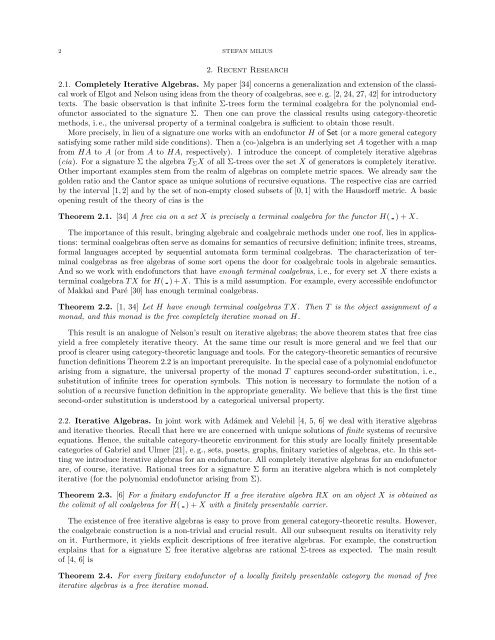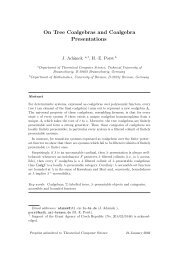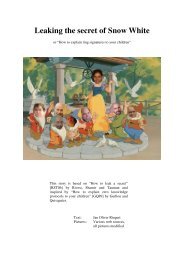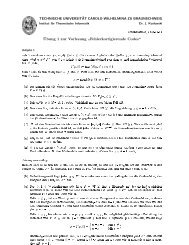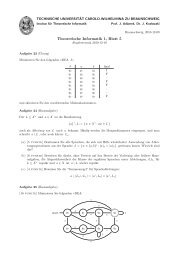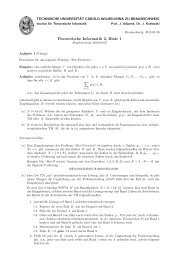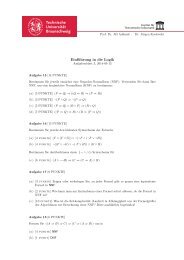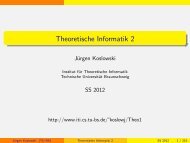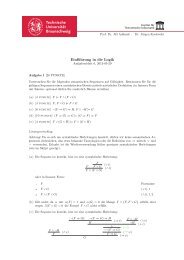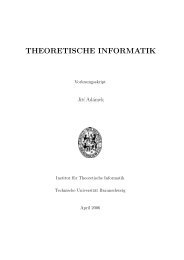RESEARCH STATEMENT My current research interests lie in ...
RESEARCH STATEMENT My current research interests lie in ...
RESEARCH STATEMENT My current research interests lie in ...
You also want an ePaper? Increase the reach of your titles
YUMPU automatically turns print PDFs into web optimized ePapers that Google loves.
2 STEFAN MILIUS2. Recent Research2.1. Completely Iterative Algebras. <strong>My</strong> paper [34] concerns a generalization and extension of the classicalwork of Elgot and Nelson us<strong>in</strong>g ideas from the theory of coalgebras, see e. g. [2, 24, 27, 42] for <strong>in</strong>troductorytexts. The basic observation is that <strong>in</strong>f<strong>in</strong>ite Σ-trees form the term<strong>in</strong>al coalgebra for the polynomial endofunctorassociated to the signature Σ. Then one can prove the classical results us<strong>in</strong>g category-theoreticmethods, i. e., the universal property of a term<strong>in</strong>al coalgebra is sufficient to obta<strong>in</strong> those result.More precisely, <strong>in</strong> <strong>lie</strong>u of a signature one works with an endofunctor H of Set (or a more general categorysatisfy<strong>in</strong>g some rather mild side conditions). Then a (co-)algebra is an underly<strong>in</strong>g set A together with a mapfrom HA to A (or from A to HA, respectively). I <strong>in</strong>troduce the concept of completely iterative algebras(cia). For a signature Σ the algebra T Σ X of all Σ-trees over the set X of generators is completely iterative.Other important examples stem from the realm of algebras on complete metric spaces. We already saw thegolden ratio and the Cantor space as unique solutions of recursive equations. The respective cias are carriedby the <strong>in</strong>terval [1, 2] and by the set of non-empty closed subsets of [0, 1] with the Hausdorff metric. A basicopen<strong>in</strong>g result of the theory of cias is theTheorem 2.1. [34] A free cia on a set X is precisely a term<strong>in</strong>al coalgebra for the functor H( ) + X.The importance of this result, br<strong>in</strong>g<strong>in</strong>g algebraic and coalgebraic methods under one roof, <strong>lie</strong>s <strong>in</strong> applications:term<strong>in</strong>al coalgebras often serve as doma<strong>in</strong>s for semantics of recursive def<strong>in</strong>ition; <strong>in</strong>f<strong>in</strong>ite trees, streams,formal languages accepted by sequential automata form term<strong>in</strong>al coalgebras. The characterization of term<strong>in</strong>alcoalgebras as free algebras of some sort opens the door for coalgebraic tools <strong>in</strong> algebraic semantics.And so we work with endofunctors that have enough term<strong>in</strong>al coalgebras, i. e., for every set X there exists aterm<strong>in</strong>al coalgebra T X for H( ) + X. This is a mild assumption. For example, every accessible endofunctorof Makkai and Paré [30] has enough term<strong>in</strong>al coalgebras.Theorem 2.2. [1, 34] Let H have enough term<strong>in</strong>al coalgebras T X. Then T is the object assignment of amonad, and this monad is the free completely iterative monad on H.This result is an analogue of Nelson’s result on iterative algebras; the above theorem states that free ciasyield a free completely iterative theory. At the same time our result is more general and we feel that ourproof is clearer us<strong>in</strong>g category-theoretic language and tools. For the category-theoretic semantics of recursivefunction def<strong>in</strong>itions Theorem 2.2 is an important prerequisite. In the special case of a polynomial endofunctoraris<strong>in</strong>g from a signature, the universal property of the monad T captures second-order substitution, i. e.,substitution of <strong>in</strong>f<strong>in</strong>ite trees for operation symbols. This notion is necessary to formulate the notion of asolution of a recursive function def<strong>in</strong>ition <strong>in</strong> the appropriate generality. We be<strong>lie</strong>ve that this is the first timesecond-order substitution is understood by a categorical universal property.2.2. Iterative Algebras. In jo<strong>in</strong>t work with Adámek and Velebil [4, 5, 6] we deal with iterative algebrasand iterative theories. Recall that here we are concerned with unique solutions of f<strong>in</strong>ite systems of recursiveequations. Hence, the suitable category-theoretic environment for this study are locally f<strong>in</strong>itely presentablecategories of Gabriel and Ulmer [21], e. g., sets, posets, graphs, f<strong>in</strong>itary varieties of algebras, etc. In this sett<strong>in</strong>gwe <strong>in</strong>troduce iterative algebras for an endofunctor. All completely iterative algebras for an endofunctorare, of course, iterative. Rational trees for a signature Σ form an iterative algebra which is not completelyiterative (for the polynomial endofunctor aris<strong>in</strong>g from Σ).Theorem 2.3. [6] For a f<strong>in</strong>itary endofunctor H a free iterative algebra RX on an object X is obta<strong>in</strong>ed asthe colimit of all coalgebras for H( ) + X with a f<strong>in</strong>itely presentable carrier.The existence of free iterative algebras is easy to prove from general category-theoretic results. However,the coalgebraic construction is a non-trivial and crucial result. All our subsequent results on iterativity relyon it. Furthermore, it yields explicit descriptions of free iterative algebras. For example, the constructionexpla<strong>in</strong>s that for a signature Σ free iterative algebras are rational Σ-trees as expected. The ma<strong>in</strong> resultof [4, 6] isTheorem 2.4. For every f<strong>in</strong>itary endofunctor of a locally f<strong>in</strong>itely presentable category the monad of freeiterative algebras is a free iterative monad.


